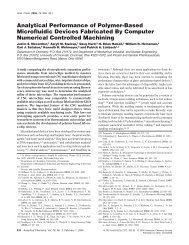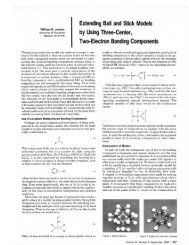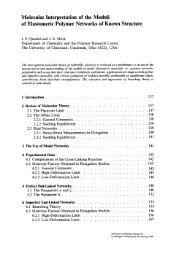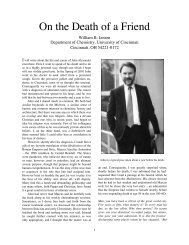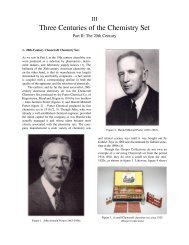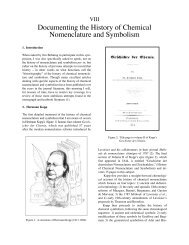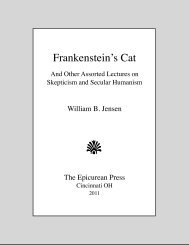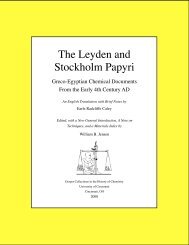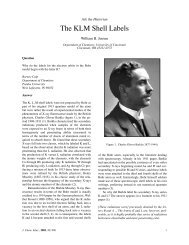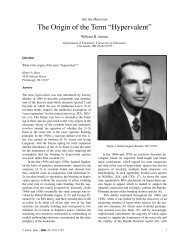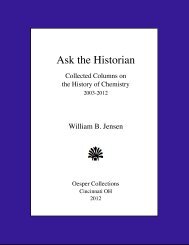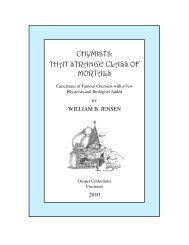043. Hans Jaffe.pdf - University of Cincinnati
043. Hans Jaffe.pdf - University of Cincinnati
043. Hans Jaffe.pdf - University of Cincinnati
You also want an ePaper? Increase the reach of your titles
YUMPU automatically turns print PDFs into web optimized ePapers that Google loves.
including my concept <strong>of</strong> the “adiabatic pliers.” As you<br />
know, a valence state is a state <strong>of</strong> an atom in a molecule<br />
like methane, rather than the ground state atom<br />
itself. To get a valence-state carbon, you take hold <strong>of</strong><br />
the carbon atom in methane with the adiabatic pliers<br />
and pull <strong>of</strong>f the protons, and the pliers hold the carbon<br />
in exactly the condition it was in the molecule.<br />
As for CNDO, when I came to <strong>Cincinnati</strong>, one <strong>of</strong><br />
my first students was Bob Gardner, and he and I (and<br />
possibly Lloyd Jones) went and took much <strong>of</strong> the spectroscopic<br />
material that we had accumulated and tried to<br />
see whether we could make sense out <strong>of</strong> it. We did<br />
some Hückel calculations and made sense out <strong>of</strong> the<br />
entire sequence <strong>of</strong> compounds that has two benzene<br />
rings connected by a bridge which may be CH=CH or<br />
N=N or other variants. We published this and John<br />
Platt referred to it as the “definitive” paper on the subject<br />
That made me happy. John Platt was the dean <strong>of</strong><br />
spectroscopists at the time. So what was I going to do<br />
after a definitive paper? Do you start somewhere else<br />
or get scared into a more definitive paper? Then Dave<br />
Beveridge came and he started to do more sophisticated<br />
calculations, that is, calculations including electron<br />
repulsion. For π-π* transitions that worked beautifully.<br />
But he couldn't handle the n-π* transitions. I tell<br />
this story <strong>of</strong>ten at seminars. What does a pr<strong>of</strong>essor do<br />
when a student comes and says that to him. It’s obvious<br />
– wait until the next student comes and say, “Now<br />
you do that.” That was Janet Del Bene. Just about that<br />
time Pople came to UC and gave a seminar on his not<br />
yet published CNDO method. Janet felt that was the<br />
kind <strong>of</strong> calculation we should do and she developed on<br />
her own from there. That’s how we got into the CNDO.<br />
I note that one <strong>of</strong> your early research grants on tautomerism<br />
was funded by the American Cancer Society. I<br />
know that in the 1950s Pullman and others were attempting<br />
to correlate the carcinogenic properties <strong>of</strong><br />
molecules with various quantum mechanical measures<br />
<strong>of</strong> unsaturation. Did you attempt to cash in on this<br />
trend as well?<br />
WILLIAM B. JENSEN<br />
14<br />
No, I was just fascinated by the game <strong>of</strong> “proton, proton,<br />
Of course the reason it was sent to the cancer people<br />
was because the molecule we were studying also happened<br />
to be a carcinogen. Milt wrote some bullshit at the<br />
front <strong>of</strong> the proposal. He was always a good BS writer<br />
when it came to grant proposals. I think there were also<br />
previous publications from the Department in that same<br />
area [the work <strong>of</strong> Francis Earl Ray in the 1940s].<br />
What are your feelings relative to current trends in<br />
funding? Sometimes I get the impression that people are<br />
doing research to get the funds rather than getting funds<br />
to do research. In other words, putting the cart before<br />
the horse.<br />
That is what I have always worried about as being the<br />
ultimate effect <strong>of</strong> making funding too important. It<br />
happens that way.<br />
What, in your own opinion, is your favorite piece <strong>of</strong><br />
work? What do you consider to be your most significant<br />
research contribution?<br />
Oh, I don’t know. That’s hard to say. The three things<br />
we talked about are the most important. The second<br />
one, the electronegativity stuff, is really Jiirgen Hinze’s<br />
and could never have been done without him, though<br />
it’s mine too. It was really a cooperative thing. The<br />
CNDO? Well, Janet did the basic program, but most <strong>of</strong><br />
the rest I did and redid. It’s not really that wild. Ultimately,<br />
the review paper on the Hammett equation<br />
which I wrote in graduate school is my favorite. It has<br />
stood up and I was still getting reprint requests 20<br />
years later. That paper also single-handedly introduced<br />
certain statistical methods into organic chemistry.<br />
Publication History<br />
This is a slight revision <strong>of</strong> an interview first published<br />
in Chem. Bond, 1989, 22, 4-16. The original publication<br />
also contains a complete list <strong>of</strong> Dr. Jaffé’s graduate<br />
students and his papers and books.



